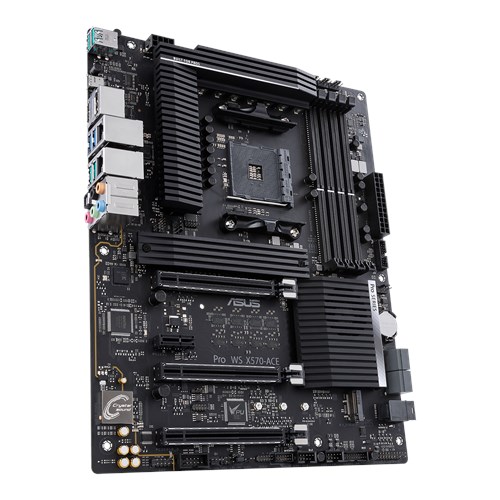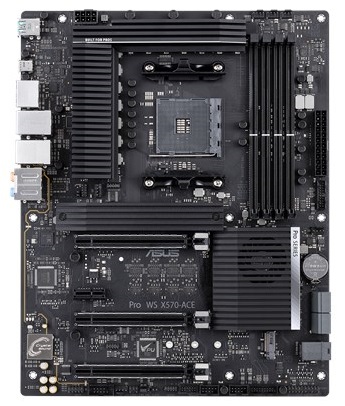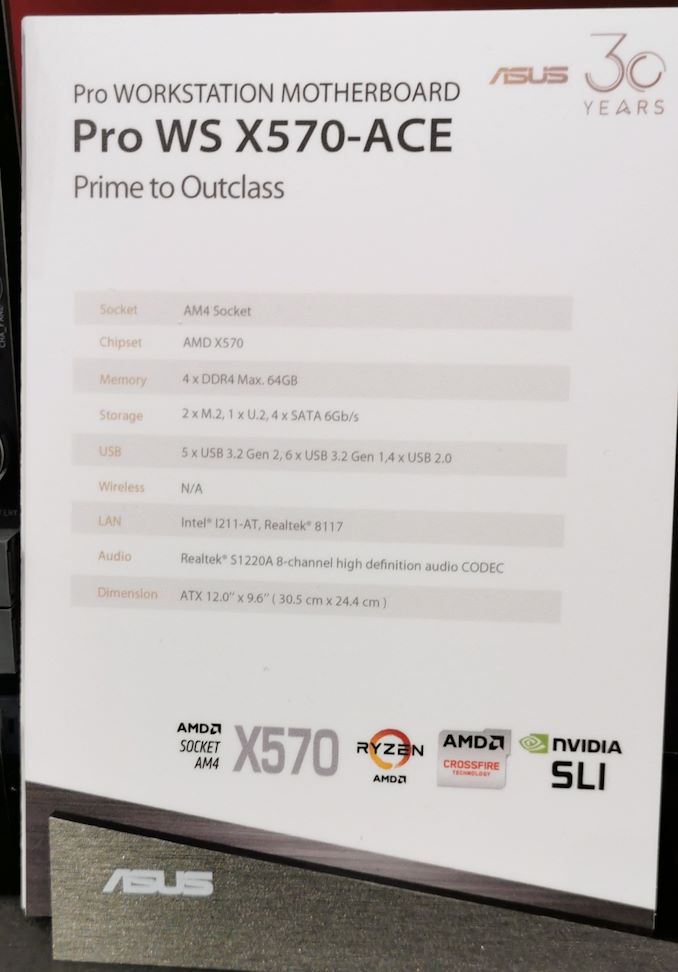ASUS Pro WS X570-Ace: A No-Nonsense All-Black Motherboard with x8/x8/x8
by Gavin Bonshor on June 6, 2019 10:00 AM EST
During Computex 2019, ASUS unveiled its range of X570 motherboards catering to various market segments. While its ROG branded boards are traditionally targeted at gamers and enthusiasts, the ASUS Pro WS X570-ACE is aimed at workstation users with official support for ECC memory, triple full-length PCIe 4.0 x8, and dual Gigabit LAN.
Some of the main traits of the ASUS WS X570-ACE include three full-length PCIe 4.0 slots which operate at x16, x8/x8, and x8/x8/x8, with that last x8 coming from the chipset. There is also a single PCIe 4.0 x1 slot. For most X570 models announced, this is one of the only models to optimize all three full-length slots at a minimum of x8. This makes this model more than interesting, as it means ASUS is fusing multiple PCIe links from the chipset into a single PCIe slot.
There are two PCIe 4.0 M.2 slots with a single U.2, and just four SATA ports. The dual LAN ports are powered by two Gigabit controllers (Intel I211-AT and Realtek 8117), with a Realtek S1220A HD audio codec driving the onboard sound. Connectivity is a focus on this model with five USB 3.1 G2 Type-A, six USB 3.1 G1 Type-A, and four USB 2.0.
The ASUS Pro WS X570-Ace follows a different design from the rest of its motherboard line-up, with straight angled heatsinks, following a uniformed black design with fins. Compared with the other ASUS X570 models, the feature set is a little thin due to its workstation focused design.
ASUS hasn't revealed any pricing for the Pro WS X570-Ace, but it is expected to launch alongside the Ryzen 3000 series processors on 7/7.
| Want to keep up to date with all of our Computex 2019 Coverage? | ||||||
 Laptops |
 Hardware |
 Chips |
||||
| Follow AnandTech's breaking news here! | ||||||













36 Comments
View All Comments
mjz_5 - Thursday, June 6, 2019 - link
whats the cost of this MB? I wish they made some more models without all the bling!JKJK - Thursday, June 6, 2019 - link
YES. I love that they are focusing more on the WS / pro range.But I FUCKING HATE that they can't give these cards 10GbE! Now I have to waste a pci-e slot on a nic. Argh!
cb88 - Thursday, June 6, 2019 - link
Well, you could use a M.2 to PCIe adapter and drive a 2 port card installed either on the other side of the GPU backwards or vertically, a bit of a kluge but it ought to work... honestly the BIOs should be providing a 10GBE controller at this point with SFP as the industry standard for the port.gggplaya - Friday, June 7, 2019 - link
The higher end ASUS X570 board actually has a multigigabit 2.5Gb ethernet port, based on the 802.3bz standard. A 10GBE controller would make the board cost $75 more dollars and since most normal consumers don't even have 10GBe NAS or other 10GBe hardware, they don't have a use for it. It would be too niche of a motherboard to sell.thomasg - Friday, June 7, 2019 - link
It's already a niche motherboard.It is marketed as a "workstation"-board after all, and I too think they should have a variant with 10 GbE.
Clearly it isn't for "most normal consumer[s]".
That said, while missing 10 GbE (or at least 5 GbE) sucks, this is still pretty much a board I've been waiting for since Ryzens release.
azrael- - Thursday, June 6, 2019 - link
This was the board I was going for ...until I realized that it, too, had active chipset cooling. That's just a no-no in my book. Not only because of the potential noise, but because these tiny, proprietary fans are bound to fail. And probably at the most inopportune moment.cb88 - Thursday, June 6, 2019 - link
Unless you are hammering the IO on the board constantly... the fan isn't even going to turn on.Xyler94 - Friday, June 7, 2019 - link
It's the unfortunate side effect of PCIe Gen 4. Higher signaling means more power hungry chipsets.But like CB mentioned, unless you are hammering it, it won't be an issue to keep the chip cool. X570 has support for multiple M.2 slots, and lots of PCIe lanes, so that little chipset has the potential to work extremely hard. But if you're careful, it won't work hard enough to be a problem.
thomasg - Friday, June 7, 2019 - link
I have to agree.ASUS does a lot right in this boards layout: all passive cooling elements are oriented in the airflow direction, have reasonable clearance and an appropriate size and are largely obstruction-free.
This is pretty much how a board should be laid out and comes close to the layout of actual professional boards.
Increasing the height of the chipset cooler slightly should be far more effective in a well-ventilated case than the puny fan.
JDG1980 - Thursday, June 6, 2019 - link
I like the overall design a lot, and I especially like the official support for ECC. There are only two drawbacks: no 10GbE support (which can be fixed with an add-on card), and that blasted fan. Would it really have been too hard for them to use a passive heatsink like the one Gigabyte put on the Aorus?